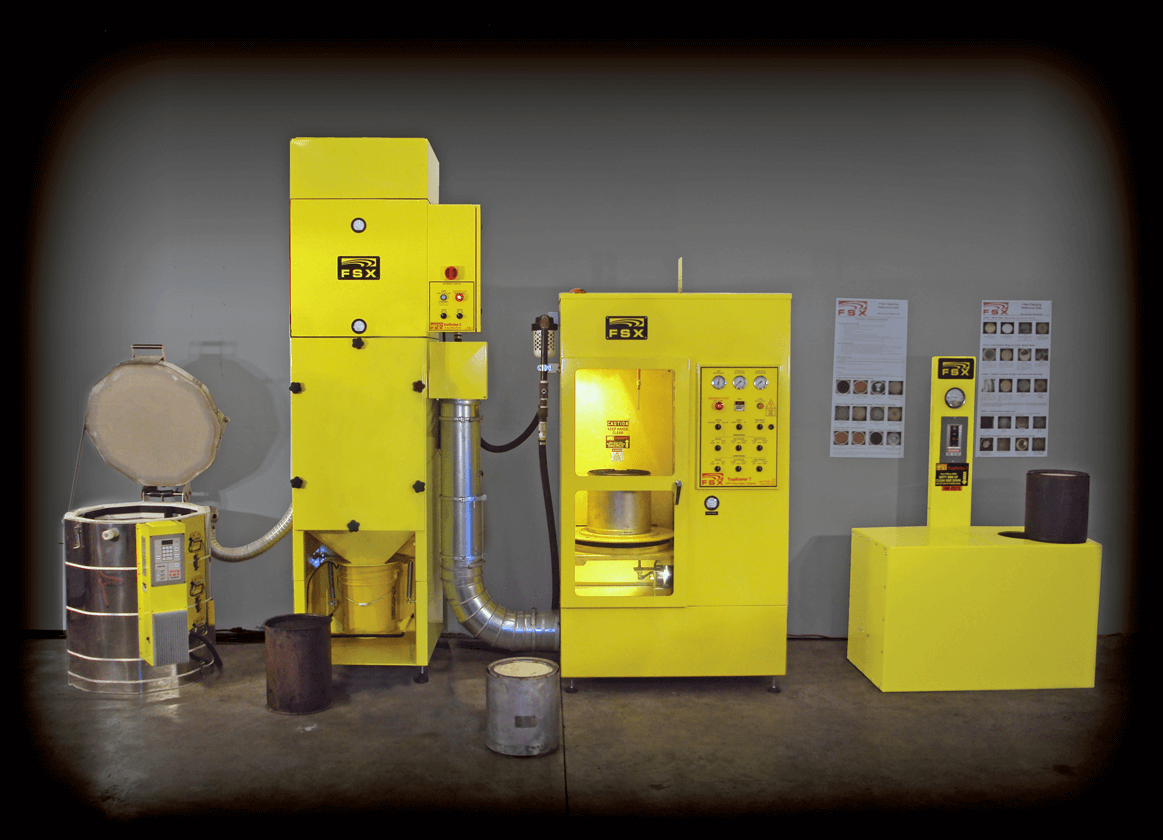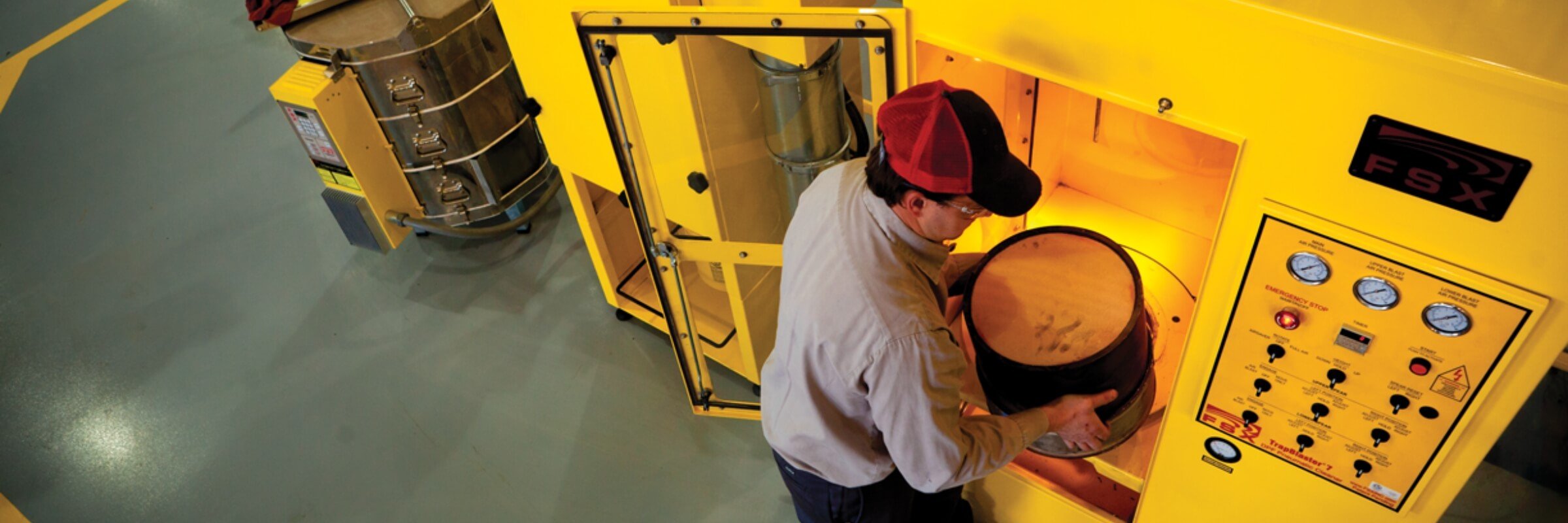Key Takeaways
- Diesel trucks are equipped with aftertreatment systems composed of a diesel particulate filter (DPF) and a diesel oxidation catalyst (DOC). The DOC chemically converts harmful gases like carbon monoxide and hydrocarbons into less harmful substances, while the DPF traps and oxidizes particulate matter, significantly reducing pollutants released into the environment.
- On-truck regeneration (passive, active, or manual) burns off soot but doesn’t remove all residue, so regular professional cleaning using air, thermal, or aqueous methods is essential to prevent clogs and maintain performance.
- OEM guidelines typically recommend cleaning the DPF every 120,000–200,000 miles (with retrofit filters requiring more frequent cleaning), and anytime the DPF is cleaned, the DOC should be inspected and cleaned as well.
Did you know that aftertreatment systems that remove pollutants from truck exhaust weren’t added to diesel trucks until 2007? Diesel engines are highly efficient and powerful, but unfortunately produce harmful emissions containing pollutants such as particulate matter (PM), carbon monoxide, hydrocarbons and nitrogen oxides (NOx). These pollutants can be harmful to both humans and the environment.
To reduce the amount of diesel emissions, trucks built since 2007 are equipped with an aftertreatment system composed of a diesel particulate filter (DPF) and a diesel oxidation catalyst (DOC) that trap pollutants and remove them from a truck’s exhaust.
Since the aftertreatment system traps these pollutants and holds onto them, the DPF and DOC can easily become clogged or rendered ineffective and need to be cleaned periodically to prevent issues. We’ve covered everything you need to know about how the DPF and DOC work and how to properly clean them to extend their lifespan.
What Do the DPF and DOC Do?
The DOC and DPF in an engine’s exhaust system work in tandem to prevent harmful diesel PM and gases from escaping into the environment. Together, they increase fuel efficiency and, most importantly, reduce emissions from diesel vehicles so that they meet emissions standards set by the Environmental Protection Agency (EPA) and the California Air Resources Board (CARB).
Diesel Oxidation Catalyst
Exhaust is first sent through the DOC, which breaks down harmful pollutants in the exhaust system via a chemical reaction. The exhaust flows through a ceramic honeycomb structure coated with precious metals such as platinum, palladium and rhodium. These precious metals cause a catalytic chemical reaction that converts carbon monoxide and hydrocarbons into carbon dioxide and water.
DOCs verified by the EPA and CARB are typically effective at reducing PM by 20–40%, hydrocarbons by 40–75% and carbon monoxide by 10–60%.
Diesel Particulate Filter
The exhaust gases then pass through the DPF, which traps and oxidizes any soot (unburned fuel/lube oil) and remaining particulates and turns them into ash. DPFs are made up of a honeycomb structure with microscopic pores that trap and hold onto the PM and ash so that it’s removed from the exhaust. The result is cleaner exhaust and reduced emissions.
Verified DPFs are typically effective at reducing emissions of particulate matter by 85–90%, as well as reducing hydrocarbons and carbon monoxide emissions by 70–90%.
Why Do the DPF and DOC Need to Be Cleaned?
Because the DPF traps PM and holds onto it, debris easily builds up over time and the pores can become clogged. The precious metal coating in the DOC can also be contaminated or degraded over time, causing it to malfunction.
A clogged DPF or malfunctioning DOC can cause engine problems, decreased fuel efficiency and higher emissions levels of harmful pollutants. For this reason, it’s essential to follow the manufacturer’s maintenance schedule and clean or replace the DPF or DOC when necessary to ensure that they’re working properly and prevent issues down the road.
Overall, regular cleaning of both the DPF and DOC extends the life of your engine and helps it perform at peak operating power.
On-Truck DPF Regeneration
One way trapped soot is removed from the DPF is through a built-in cleaning process in diesel engines called DPF regeneration, or regen for short. DPF regen is the process of burning off accumulated soot and ash using very high temperatures to prevent the DPF from becoming clogged. The effectiveness of DPF regen at preventing clogs depends on the make of the engine, the type of DPF and driving conditions. There are three types of regen: passive, active and manual.
Passive Regeneration
Passive regeneration happens naturally while driving without the driver having to initiate the cleaning process. In order for the engine’s exhaust gases to reach high enough temperatures for the soot and ash to be burned off (greater than 350°C or 662°F), the vehicle must be driving at 70 mph or above for at least 45 minutes.
Due to the need for maintained high speeds and high temperatures, this method is not as effective at cleaning the DPF for drivers who primarily make short trips, are frequently in stop-and-go traffic or drive consistently in cold weather conditions.
Active Regeneration
If temperatures aren’t high enough for passive regeneration to occur naturally, active regeneration is required. Active regen is a more controlled cleaning process that is initiated automatically by the vehicle’s engine control unit (ECU) when the filter has reached a certain soot capacity. The ECU triggers the process of post-combustion fuel injection, which injects additional fuel into the DOC to raise the exhaust temperature high enough (around 550–650°C or 1,000–1,200°F) to initiate the cleaning process and burn off trapped soot and ash.
Manual Regeneration
Unlike passive and active regeneration, which do not require the driver to start the process, manual regeneration requires the driver to take action in order to clean the DPF. If the DPF becomes clogged and cannot self-clean, a DPF warning light may illuminate on the dashboard. When this occurs, the driver should park the vehicle and enable manual regeneration. This process increases the engine RPM and injects additional fuel into the engine to generate appropriate regeneration temperatures. It typically takes about 30 minutes.
Professional DPF and DOC Cleaning Methods
Unfortunately, on-truck regeneration does not remove everything from the DPF, and the filter must be removed from the engine periodically to completely remove any noncombustible materials and ash. And anytime the DPF is removed for cleaning, the DOC should be removed, inspected and cleaned as well.
It is not recommended to try and clean the DPF or DOC on your own, as it could result in damage that requires the parts to be completely replaced. Professional technicians can thoroughly and safely clean both DPFs and DOCs using special cleaning devices while also ensuring that they’re receiving proper airflow and meet EPA standards. There are typically three cleaning methods truck repair shops use to properly clean and restore DPFs and DOCS: air, thermal and aqueous.
- Pneumatic Air Cleaning – In some cases, the DPF can be cleaned using air alone. This process involves using compressed air to loosen and force contaminants out of the filter.
- Thermal Cleaning – Air cleaning is often not enough on its own, and heat is required to remove contaminants. This process involves heating the DPF to high temperatures (typically 500–600°C or 932–1,112°F) in a special oven device to evaporate and oxidize built-up soot and PM. Thermal cleaning typically takes about a day, including heating time and cool down.
- Aqueous Cleaning – This process involves using a non-destructive cleaning solution that surrounds the ash particles to make it easy for water to wash the ash out of the pores of the DPF. The DPF is then dried in a special drying cabinet and can be reinstalled in about two hours.

How Often Should Your DPF and DOC Be Professionally Cleaned?
Most diesel vehicles have an onboard filter service monitor that indicates the filter’s condition and can help guide your cleaning schedule. Most engine OEMs recommend maintenance and cleaning of your DPF every 120,000 to 200,000 miles, or every six to 12 months. Retrofit DPFs may require more frequent cleaning every 60,000 miles. This prevents soot and ash from becoming so hardened that they’re difficult to remove. Delaying regular cleanings can increase the chances that the filter will need to be replaced.
However, how often your DPF and DOC need to be cleaned depends on the vocation and application the truck is being used for. Trucks used for mostly highway driving and carrying heavy loads that are able to achieve passive regeneration can go much longer between cleanings than trucks used for applications that require a lot of starting and stopping or working off road.
If you start to notice problems like an increase in the frequency of regeneration cycles, a decline in engine performance, strong exhaust smells, reduced efficiency or engaged cooling fans, it may be a sign that the DPF is clogged and requires professional cleaning.
How Long Do DPFs and DOCs Last?
A well-maintained, properly cleaned or new DPF and DOC should remain effective for generally five to 10 years, or 10,000 or more hours of operation. Engine problems with fuel control or oil consumption may quickly deteriorate performance and lead to the need for replacement parts sooner. In fact, 80% of DOC and DPF failures are premature due to engine-related issues. Since DOCs do not have any moving parts, they typically have a longer life cycle if properly maintained and cleaned.
When the time does come to replace a DPF, they generally cost anywhere from $5,000 to $15,000 or more, depending on the engine size, filter technology and installation requirements. DOC replacement generally costs between $600 and $2,000.
Same-Day DPF and DOC Cleaning at Rush Truck Centers
Rush Truck Centers offers same-day DPF and DOC cleaning services at our dealerships nationwide. Our factory-trained technicians use state-of-the-art TrapBurner thermal cleaning and pneumatic air cleaning technology to return your DPF and DOC to peak operating condition. Submit a service request or contact your closest Rush Truck Centers location to schedule an appointment for your next cleaning.
COME ALONG FOR THE RIDE. Sign up to receive email updates with our latest promotions, blog posts and news from Rush Truck Centers.

 Back To Blog
Back To Blog




